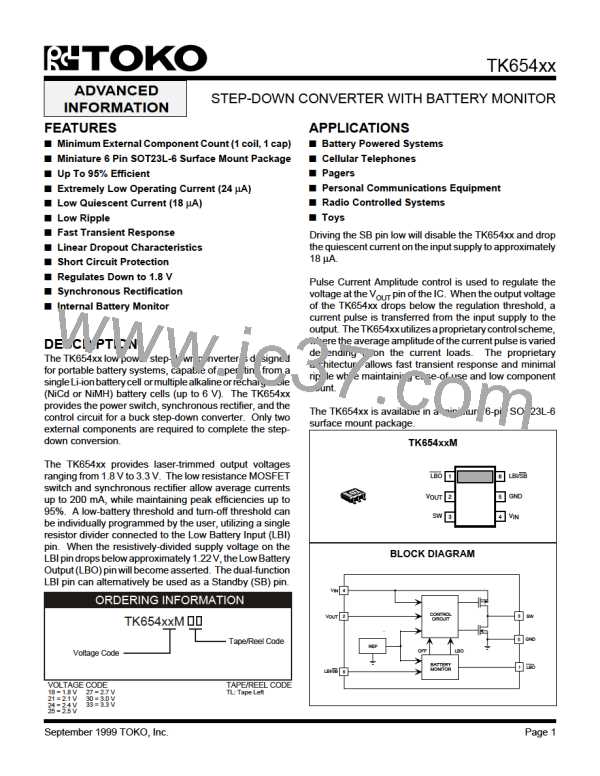ADVANCED INFORMATION
TK654xx
APPLICATION INFORMATION (CONT.)
Toko Inc. has come up with such a proprietary architecture implemented in their TK654XX switching step down converter.
This device is full of features as itemized in the following section:
TK654XX Features
1)
2)
Minimum pin count. Only 6 pins in a SOT23L package
Minimum external components required:
Coil and Filter cap
3)
Synchronous Rectification
4)
5)
Extremely low operating current (25uA).
18uA Standby Currents
6)
7)
Internal power devices good for greater than 200mA loads
Inherent short circuit protection
8)
No instabilities
9)
Fast transient response
10)
11)
12)
13)
14)
15)
16)
High efficiencies up to 95%
Regulation down to 1.8V
Proprietary architecture specifically aims at low ripple voltage.
Low Dropout operation (100% Duty Cycle)
Designed for battery operated equipment
Battery Monitor included
Easy to design with (Reduce the coil to increase the load current)
Explanation of Figs. 10, 11, 12 follows:
Figure 10, shows a battery operated system with communications capability. The microcontroller is programmed to turn
on / off the Linear Low Dropout regulators (LDOs) at the appropriate time. This enabling capability is useful in extending
the battery life. Please note the LDO C, which powers the microcontroller is always active.
Figure 11, takes advantage of LDO C having to be active continuously and replaces it with a PWM step down controller.
Though the PWM is always active like the LDO C of Figure 10, the PWM is more efficient and therefore is penetrating the
Wireless market in order to increase battery life. It must be pointed out in Figure 11, the role of the LDOs is important to
maintain the clean voltages for Transmission and reception modes. Figure 11 also points out that if there is small activity
withthemicrocontrollerwhichcontrolstheotherLDOs, thesystemcouldtriptothe“BurstMode”tauntedbysemiconductor
manufacturers. This mode is intended to reduce the current consumption of the PWM and increase the overall battery
life. Unfortunately, the speed that this Burst mode-to-PWM mode can react in is not very fast. Those systems, which are
compromised to increase response time, will inevitably hurt in ripple and therefore noise performance.
Figure 12, replaces the PWM with a Buck (step down) converter which has a unique architecture to respond very fast from
“Burst mode” to full load operation and a linear in parallel, rather than in series which can be enabled at the time the system
requires to transmit or receive. It is only due to the clean RF that the LDO is necessary. The majority of the time these
wireless systems are in a mode which can operate with some noise in the main voltage line. Some readers may have
noticed that Figure 12 only requires 1 LDO versus 3 LDOs in Figure 11. This principal may point out that the overall system
may turn out to be more cost effective. The system shown in Figure 12, therefore not only extends the overall battery life
by allowing the system to go into standby modes where the overall current is in the order of 25 uA, but at full load can run
in the 95% efficiency (no Transmission / Receive mode). Figure 12 can maintain the clean RF requirements for wireless
communications and reduce the overall cost.
September 1999 TOKO, Inc.
Page 23

 TOKO [ TOKO, INC ]
TOKO [ TOKO, INC ]